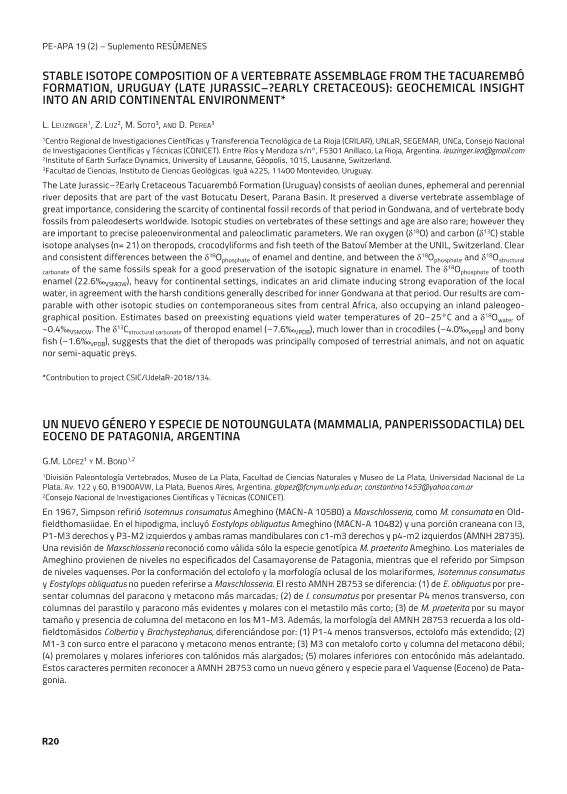Mostrar el registro sencillo del ítem
dc.contributor.author
Leuzinger, Léa Sylvia

dc.contributor.author
Luz, Z.
dc.contributor.author
Soto, M.
dc.contributor.author
Perea, D.
dc.date.available
2022-05-06T14:18:05Z
dc.date.issued
2019
dc.identifier.citation
Stable isotope composition of a vertebrate assemblage from the Tacuarembó Formation, Uruguay (Late Jurassic-Early Cretaceous): Geochemical insight into an arid continental environment; 33as Jornadas Argentinas de Paleontología de Vertebrados; Córdoba; Argentina; 2019; 20-20
dc.identifier.issn
2469-0228
dc.identifier.uri
http://hdl.handle.net/11336/156782
dc.description.abstract
The Late Jurassic–Early Cretaceous Tacuarembó Formation (Uruguay) consists of aeolian dunes, ephemeral and perennial river deposits that are part of the vast Botucatu Desert, Parana Basin. It preserved a diverse vertebrate assemblage of great importance, considering the scarcity of continental fossil records of that period in Gondwana, and of vertebrate body fossils from paleodeserts worldwide. Isotopic studies on vertebrates of these settings and age are also rare; however they are important to precise paleoenvironmental and paleoclimatic parameters. We ran oxygen (δ18O) and carbon (δ13C) stable isotope analyses (n=21) on theropods, crocodyliforms and fish teeth of the Batoví Member at the UNIL, Switzerland. Clear and consistent differences between the δ18Ophosphate of enamel and dentine, and between the δ18Ophosphate and δ18Ostructural carbonate of the same fossils speak for a good preservation of the isotopic signature in enamel. The δ18Ophosphate of tooth enamel (22.6‰VSMOW), heavy for continental settings, 53 indicates an arid climate inducing strong evaporation of the local water, in agreement with the harsh conditions generally described for inner Gondwana at that period. Our results are comparable with other isotopic studies on contemporaneous sites from central Africa, also occupying an inland paleogeographical position. Estimates based on preexisting equations yield water temperatures of 20–25°C and a δ18Owater of ~0.4‰VSMOW. The δ13Cstructural carbonate of theropod enamel (–7.6‰VPDB), much lower than in crocodiles (–4.0‰VPDB) and bony fish (–1.6‰VPDB), suggests that the diet of theropods was principally composed of terrestrial animals, and not on aquatic nor semiaquatic preys.
dc.format
application/pdf
dc.language.iso
spa
dc.publisher
Asociación Paleontológica Argentina

dc.rights
info:eu-repo/semantics/openAccess
dc.rights.uri
https://creativecommons.org/licenses/by-nc/2.5/ar/
dc.subject
Stable isotopes
dc.subject
Late Jurassic
dc.subject
Continental vertebrates
dc.subject
Fm Tacuarembó
dc.subject.classification
Geoquímica y Geofísica

dc.subject.classification
Ciencias de la Tierra y relacionadas con el Medio Ambiente

dc.subject.classification
CIENCIAS NATURALES Y EXACTAS

dc.title
Stable isotope composition of a vertebrate assemblage from the Tacuarembó Formation, Uruguay (Late Jurassic-Early Cretaceous): Geochemical insight into an arid continental environment
dc.type
info:eu-repo/semantics/publishedVersion
dc.type
info:eu-repo/semantics/conferenceObject
dc.type
info:ar-repo/semantics/documento de conferencia
dc.date.updated
2022-03-17T14:03:51Z
dc.journal.volume
19
dc.journal.pagination
20-20
dc.journal.pais
Argentina

dc.journal.ciudad
Córdoba
dc.description.fil
Fil: Leuzinger, Léa Sylvia. Consejo Nacional de Investigaciones Científicas y Técnicas. Centro Regional de Investigaciones Científicas y Transferencia Tecnológica de La Rioja. - Universidad Nacional de La Rioja. Centro Regional de Investigaciones Científicas y Transferencia Tecnológica de La Rioja. - Universidad Nacional de Catamarca. Centro Regional de Investigaciones Científicas y Transferencia Tecnológica de La Rioja. - Secretaría de Industria y Minería. Servicio Geológico Minero Argentino. Centro Regional de Investigaciones Científicas y Transferencia Tecnológica de La Rioja. - Provincia de La Rioja. Centro Regional de Investigaciones Científicas y Transferencia Tecnológica de La Rioja; Argentina
dc.description.fil
Fil: Luz, Z.. Universite de Lausanne; Suiza
dc.description.fil
Fil: Soto, M.. Universidad de la República. Instituto de Ciencias Geológicas; Uruguay
dc.description.fil
Fil: Perea, D.. Universidad de la República. Instituto de Ciencias Geológicas; Uruguay
dc.relation.alternativeid
info:eu-repo/semantics/altIdentifier/url/https://www.peapaleontologica.org.ar/index.php/peapa/article/view/307
dc.conicet.rol
Autor

dc.conicet.rol
Autor

dc.conicet.rol
Autor

dc.conicet.rol
Autor

dc.coverage
Nacional
dc.type.subtype
Jornada
dc.description.nombreEvento
33as Jornadas Argentinas de Paleontología de Vertebrados
dc.date.evento
2019-05-29
dc.description.ciudadEvento
Córdoba
dc.description.paisEvento
Argentina

dc.type.publicacion
Journal
dc.description.institucionOrganizadora
Universidad Nacional de Córdoba. Facultad de Ciencias Exactas, Físicas y Naturales
dc.description.institucionOrganizadora
Universidad Nacional de Córdoba. Facultad de Ciencias Exactas, Físicas y Naturales. Museo de Paleontología
dc.description.institucionOrganizadora
Museo Provincial de Ciencias Naturales Dr. Arturo Umberto Illía
dc.description.institucionOrganizadora
Centro de Investigaciones en Ciencias de la Tierra
dc.source.revista
Publicación electrónica de la Asociación Paleontológica Argentina
dc.date.eventoHasta
2019-05-31
dc.type
Jornada
Archivos asociados
